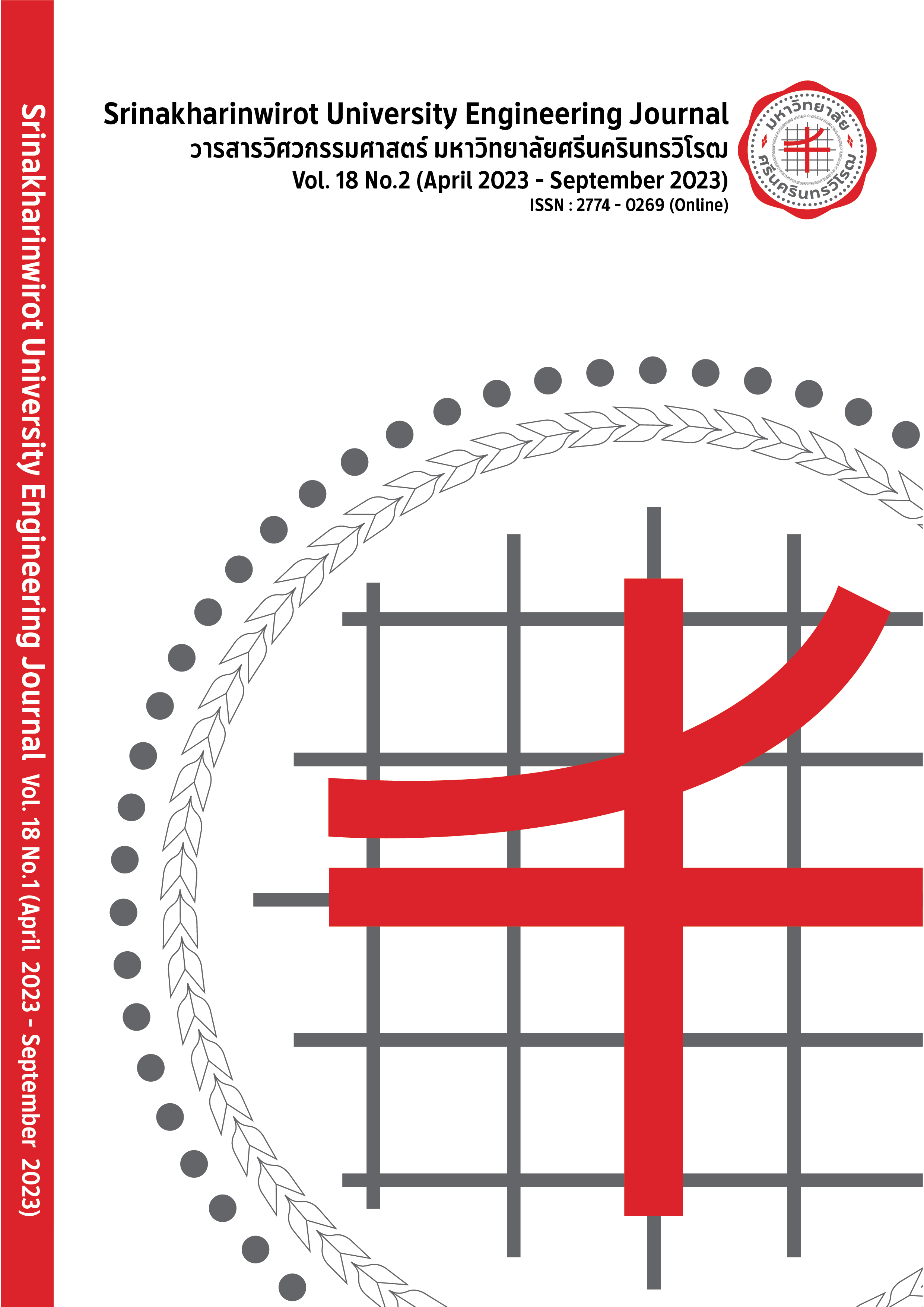การศึกษาคุณลักษณะการเผาไหม้และประสิทธิภาพเชิงความร้อนของเตาชีวมวลทรงกระบอก
Main Article Content
บทคัดย่อ
งานวิจัยนี้มีวัตถุประสงค์เพื่อศึกษาคุณลักษณะการเผาไหม้ และประสิทธิภาพเชิงความร้อนของเตาชีวมวลทรงกระบอกด้วยวิธีการทดสอบโดยการต้มน้ำ (Water boiling test) เพื่อหาเงื่อนไขที่เหมาะสมที่สุดในการนำไปประยุกต์ใช้งาน ตัวแปรในการบรรจุขี้เลื่อยของเตาชนิดนี้ ได้แก่ แรงดันในการอัด และความชื้นของชีวมวล โดยชีวมวลที่ใช้ในการทดลอง คือ ขี้เลื่อย อัดบรรจุในเตาชีวมวลทรงกระบอก ด้วยความดันในการอัดบรรจุ 40 bar 80 bar และ 120 bar และความชื้นของขี้เลื่อย คือ 10% 15% 20% และ 25% จากการทดลองพบว่าพฤติกรรมการเผาไหม้เตาชีวมวลทรงกระบอกที่แรงดันในการอัด 40 bar 80 bar และ 120 bar ให้ระยะในการเผาไหม้ต่อเนื่อง 4 ชั่วโมง 6 ชั่วโมง และ 7 ชั่วโมง ตามลำดับ เมื่อใช้ขี้เลื่อย 15% และอัดที่ความดัน 40 bar จะให้อุณหภูมิสูงสุดของเปลวไฟเฉลี่ยตลอดระยะเวลาการเผาไหม้ที่ 703 ๐C และที่ความชื้นของขี้เลื่อย 15% ของทุกแรงดันในการอัดให้ประสิทธิภาพเชิงความร้อนสูงที่สุด คือ 16.24% 14.38% และ 20.26% ตามลำดับ ที่ชั่วโมงที่ 2 ของการทำงานของเตา
Article Details

อนุญาตภายใต้เงื่อนไข Creative Commons Attribution-NonCommercial-NoDerivatives 4.0 International License.
ลิขสิทธิ์เป็นของวารสารวิศวกรรมศาสตร์ มหาวิทยาลัยศรีนครินทรวิโรฒ
เอกสารอ้างอิง
Department of Alternative Energy Development and Efficiency, Ministry of Energy. Biomass Potential in Thailand [online] .Available: https://www.dede.go.th/ewt_news.php?nid=486
S. Jodnok, “Operating Characteristics Validation of a Novel Cylindrical Compression Biomass Stove”, in 6TH CONFERENCE ON ENERGY NETWORK OF THAILAND (E-NETT), Bangkok, 2010.
T. Chaichana, “The Study of Thermal Efficiency of Household Cooking Stove”, Science and Technology Journal Mahasarakham University, vol. 32, pp. 626-630, 2013.
W. Khumhem, “The Study of Thermal Efficiency of biomass stove under continuous fuelfeeding”, in 13TH CONFERENCE ON ENERGY NETWORK OF THAILAND (E-NETT), Chiangmai, 2017, pp. 251-256.
Department of Alternative Energy Development and Efficiency, Ministry of Energy. Development and transfer of production technology and utilization of cylindrical biomass stoves [online] .Available: http://e-lib.dede.go.th/mm-data/Bib13842-รายงานฉบับสมบูรณ์.pdf
T. Jain and P. N. Sheth, “Design of energy utilization test for a biomass cook stove : Formulation of an optimum air flow recipe,” Energy, vol. 166, no. 1 pp. 1097-1105, 2019
A. Hosungnoen and Y. Thanwongsa, “Rice husk Cooking Stove for Household”, in The National Graduate Research Conference , Khon Kaen, 2011, pp. 574-578
F. Khlaayaecchng, T. Chorchong and P. Maneechot, “The performance test of a small biomass gas stove using centrifugal blower for combustion”,in 7th Thailand Renewable Energy for Community Coference, Nakhon Pathom, 2014, pp. 171-176.
P. Khaonuan, S. Prasongchan and S. Bordeepong “Performance development of household biomass TLUD cookstove”, UTK research journal, vol.14, no.1, pp. 52-62, 2020.
S. Kaewluan, D. Junthosi , S. Jansri and W. Piyarat “Performance testing of the 20 kW Biomass Gas Stove”, SWU Engineering Journal, vol. 18, no. 1, pp. 24-33, 2013


